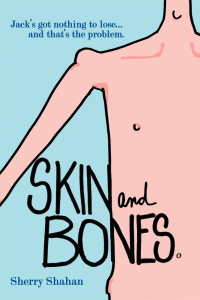Short Story Month: Guest Post from Sherry Shahan: From Short Story to Novel, in 60,000 Words
Many years ago I came up with a quirky idea for a short story featuring teens in an Eating Disorders Unit of a metropolitan hospital. Sort of “One Flew Over the Cuckoo’s Nest” meets “Love Story,” only told in 5 pages.

Albert Whitman Teen, March 2014.
Then titled “Iris and Jim,” it quickly sold to a major literary journal, ZZYZVA. Later, a London publisher included “Iris and Jim” in their YA anthology, and subsequently in their Best of collection. In total “Iris and Jim” has been published eight times worldwide. There was just something about this wacky story . . ..
My agent encouraged me to expand “Iris and Jim” (now titled SKIN AND BONES) into a novel. Sure, easy for her to say. I spent months weighing the pros and cons of such a daunting undertaking.
Pros:
The short story would serve as an outline since the basic story arc was in place.
Each character already had a distinctive voice.
The hospital setting was firmly fixed in my mind.
The story’s tone would lend itself to a longer format, particularly when developing snarky dialogue.
The subject matter had proven itself to be of interest to readers.
Proven ground is attractive to editors and publishers, as long as the topic is approached in a fresh way.
Cons:
The story would require an additional 60,000 words.
I’d have to create new characters.
Every character would require a convincing backstory.
I’d have to develop compelling subplots.
Every scene would need emotional subtext.
One voice in my head said, “Can you handle spending a year with teens suffering from potentially life-threatening disorder?” Another voice, the louder, stupider one said, “Why not give it a try?”
During the first draft I encountered a number of unexpected obstacles. For instance, how could I keep up the idiosyncratic tone without the narrator sounding flippant? Eating disorders (anorexia, bulimia, compulsive over-eating, etc.) are serious, and in too many instances can result in death. It took several drafts before the tone felt balanced.
More than one anorexic in my story figures out how to beat the health care system. Research led me to memoirs where I learned that they’re experts at manipulating parents and each other, as well their environment. Yet I worried about Skin and Bones becoming a how-to manual for those still in the throes of the disease.
On the other hand, I knew I had to include information about the potentially grave consequences associated with the illness. But I didn’t want to sound didactic. Sometimes I sprinkled facts into farcical scenes. Other times statistics emerged in dialogue between ranting patients. Either way, disseminating information felt more organic when slipped in sideways, and never straight on.
httpvs://www.youtube.com/watch?v=QIPVkS-ie2A
More than one person in my critique group questioned the validity of males with eating disorders—even though experts estimate that 10 million adolescent males suffer from the illness. Research helped me develop a realistic backstory to explain why my protagonist had slipped into this dangerous abyss.
Each revision (some 10 drafts in all) brought new challenges, some of which required me to step away from the hospital and my characters. I sometimes spent days away from my computer and returned to my work with a fresher perspective.
Shortly after Wendy McClure at Whitman acquired the manuscript I received a list of astute questions, including:
What’s inside Jack (Bones) that predisposes him to anorexia? (This needs to be a recurring motif throughout the book, whatever it is.)
Can you emphasize Bones’ terror in terms of what he does (wearing rubber gloves to avoid absorbing calories when he eats) in this scene, rather than what he thinks?
David (Lard) is a compulsive overeater. Semantics aside, what is it about his disorder that requires him to be hospitalized? Kids aren’t locked up in eating disorder units just to lose weight.
More general comments:
Be careful of re-treading certain elements, especially parts where
Bones obsesses over calories.
Is there a better way to pace the plot points?
Re: Parody. Wouldn’t these scenes be funnier—and less cartoony—if
the details came out in dialogue between the characters?
Other notes included minor issues with pacing, structure, and chronology, as well as tweaking chapter ends to increase page-turning tension. But, then, I’d expect these types of editorial notes even if the novel hadn’t grown out of a short story.
I really had to think about the pulse of a novel and how it differs from a short story. The pacing is more generous. The theme more layered. I had the freedom of spending more time with my characters. This meant readers will know more about where they’re coming from; the intricacies of their motivation, goals, and actions. What might have originally been an internal thought often became a powerful piece of dialogue.

Sherry Shahan.
Sherry Shahan is known for her adventure-slash-survival novels ICE ISLAND, FROZEN STIFF (both Random House), and DEATH MOUNTAIN (Peachtree). All are metaphors for teens surviving life’s emotional hardships. She holds an MFA in Writing for Children and Young Adults from Vermont College of Fine Arts and lives in a laid-back beach town on California’s Central Coast. Visit www.SherryShahan.com








